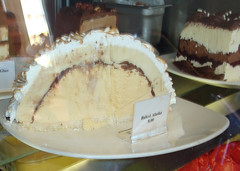How many of you know what Baked Alaska is?
An article in Cooks Illustrated puts it nicely: "Baked Alaska is what the French call a bombe, or a layered assemblage of ice cream and cake. Instead of being served cold, it is slathered with a thick layer of sweet meringue and baked until golden. In a bit of kitchen wizardry, the fluffy whipped egg whites insulate the ice cream and protect it from melting despite the oven's withering heat."
At Cakespy, we'd always had a vague romantic notion of this dessert without actually knowing what it was. But after recently trying it for the first time at Papa Haydn, in Portland, OR, we were hooked; we wanted to know everything about this unusual dessert. So we put on our sleuthing clothes, and here's what we found out:
Turns out, the lineage of this lovely dessert does not begin in France as we had originally thought, but in China, where the idea of cooking a cold dessert encased with pastry seems to have originated. The concept came to France when Chinese delegates made a visit to Paris and the concept was passed off to a pastry chef. the addition of the meringue layer in the early 1800s is credited to Benjamin Thompson, an American physicist living in Europe, who realized that while pastry would conduct much of the heat and protect the cold core, a layer of meringue would do so to even greater a degree. Due to its snowy appearance and chilly core, it was dubbed the "omelette á la norvégienne". Its popularity caught on during the Victorian era, and these elaborate confections were made in various fancy shapes and were frequently called "Bombes".
In 1876 it made its stateside debut via Delmonico's Restaurant in NYC, where Charles Ranhofer made the dessert in celebration of the newly acquired Alaska Territory. Originally called "Alaska-Florida" (the whole hot-cold thing, we think) it was eventually shortened to "Baked Alaska". Now, this recipe is not only ingredient but time intensive; it doesn't really have a "downmarket" version, which seems to have been a big factor in its popularity. It became known as a dessert for the privileged, and was served and popularized by chefs like Jean Giroix of the Hotel de Paris Monte Carlo. It was undoubtedly this fancy-dessert status which led the confection to be featured in several important American cookbooks of the era, perhaps most notably the Fannie Farmer Cookbook, which ultimately sealed its place in American culture.
It grew to be a popular hostess dessert and piece de resistance during 60's and 70's, but went the way of bell bottoms and disco clothes in the 80's and was absent from the dessert scene for many years. And on one level we can see why; of course, other than tastes changing, it is a draining dessert to make and rather daunting a project to take on.
Nonetheless, like so many things that must be worked for, once you've tasted a good Baked Alaska, you'll know it can be worth the journey.
Cakespy Note: This post would not have been possible without references from What's Cooking America, Wikipedia, Foodreference.com, Cooks Illustrated, Hub-uk.com,
A note on Recipes: in our journeys, we found several recipes for Baked Alaska; we found the most user-friendly one to be in this year's special holiday baking issue of Cooks Illustrated, in the article entitled "Demystifying Baked Alaska". We also found this cute one online at the Food Network.
Baked Alaska Trivia (Sources: Wikipedia, What's Cooking America)
A variation called Bombe Alaska calls for some dark rum to be splashed over the Baked Alaska. Lights are then turned down and the whole dessert is flambéed while being served.
In 1969, the recently invented microwave oven enabled Hungarian physicist and molecular gastronomist Nicholas Kurti to produce a "reverse Baked Alaska", aka Frozen Florida (hot on the inside and cold on the outside).
Thomas Jefferson was a fan of the dish, and served it at his dinner parties: from the web site The Home of Thomas Jefferson, one visitor reportedly commented: "Among other things, ice-creams were produced in the form of balls of the frozen material enclosed in covers of warm pastry, exhibiting a curious contrast, as if the ice had just been taken from the oven."

